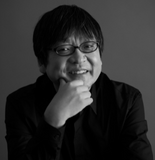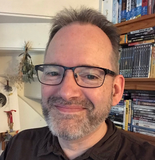
A celebration of the talent and legacy of important animated projects with the creators who made them happen.
Celebrated Academy Award®-nominated director Mamoru Hosoda has long been interested in stories that explore growing up and in his latest film Belle, he tackles the subject by introducing us to Suzy, a shy high school student who lives an alternate life on social media.
In this hour-long conversation, Hosoda discusses everything from the concept of the new film and some of the common themes that appear throughout his projects, to working with Cartoon Saloon and what his next project would be if money was no object.
Image courtesy © 2021 STUDIO CHIZU. All Rights Reserved.
SPEAKER
 Mamoru Hosoda
Mamoru Hosoda
Director // Studio Chizu
(The Girl Who Leapt Through Time, Summer Wars, The Wolf Children, Mirai, Belle)
Mamoru Hosoda was born in Toyama in 1967. After graduating from Kanazawa Art College, Hosoda joined Toei Doga (now Toei Animation Co., Ltd.) as an animator.
In 1997, he made his directorial debut with the popular animation TV series GeGeGe no Kitarō (4th season). In 1999, he directed his first animated film Digimon Adventure but it was with his second go for Digimon Adventure: Our War Game that he began to gain notoriety.
He then became a freelancer and, in 2006, he directed the film The Girl Who Leapt Through Time, which was not only a huge success in Japan but also further afield. It was widely distributed and even won an award at the Annecy International Animation Festival in France.
In 2009, he directed Summer Wars, the first “geek” family film, which is still a culture reference point for the younger generation today.
In 2011, he founded his own animation studio called Studio Chizu with his long-time producer Yuichiro Saito. The first film to come out of this young studio was The Wolf Children (2014) and subsequently the Boy and the Beast (2016), which confirmed Hosoda’s immense popularity in Japan and further afield.
With Mirai, Hosoda’s animation talent gained international recognition. Mirai was nominated for an Oscar in the Best Animation Film category, as well as for the Director’s Fortnight at Cannes, and won Best Independent Animation Award at the 46th Annie Awards.
MODERATORS
 Peter van der Lugt
Peter van der Lugt
Writer // Screen Anarchy
Peter van der Lugt has been writing about film and animation for over twenty years now. While live-action wise he has had the honor of covering a multitude of film festivals—Venice Film Festival still remains his favorite—and talking to acclaimed directors like Kore-eda Hirokazu, Johnny To and Tsai Ming-Liang, his increased interest in animation has brought him to having done extensive one-on-one interviews with the likes of Takahata Isao, Yuasa Masaaki, Tomm Moore, Michel Ocelot and Enrico Casarosa.
Outside of film and animation, Peter is frequently found in Japan, due to his involvement in Akita Inu—a designated natural monument of Japan—as a breeder, breed specialist and Vice-President Europe for Japan’s long established Akita Inu Hozonkai.
 Ard Vijn
Ard Vijn
European Editor // Screen Anarchy
Ard Vijn lives in Rotterdam, the Netherlands and started writing for the Canadian Screen Anarchy website in November 2006 (it was named differently then). The initial goal was to share information about the Dutch film industry, but during his visits to film festivals he discovered he was actually more interested in Asian cinema in general. Japanese animation is one of his favorite topics.
Currently he is one of the European Editors of Screen Anarchy, and is a contributing writer for the Dutch genre film magazine Schokkend Nieuws. He juggles his time between his wife and two sons, a career as an Operational Manager in a big energy company, writing about films, collecting films, and actually seeing films.
Website // IMDb // Facebook // Twitter // Instagram // LinkedIn
A celebration of the talent and legacy of important animated projects with the creators who made them happen.
Celebrated Academy Award®-nominated director Mamoru Hosoda has long been interested in stories that explore growing up and in his latest film Belle, he tackles the subject by introducing us to Suzy, a shy high school student who lives an alternate life on social media.
In this hour-long conversation, Hosoda discusses everything from the concept of the new film and some of the common themes that appear throughout his projects, to working with Cartoon Saloon and what his next project would be if money was no object.
Image courtesy © 2021 STUDIO CHIZU. All Rights Reserved.
SPEAKER
 Mamoru Hosoda
Mamoru Hosoda
Director // Studio Chizu
(The Girl Who Leapt Through Time, Summer Wars, The Wolf Children, Mirai, Belle)
Mamoru Hosoda was born in Toyama in 1967. After graduating from Kanazawa Art College, Hosoda joined Toei Doga (now Toei Animation Co., Ltd.) as an animator.
In 1997, he made his directorial debut with the popular animation TV series GeGeGe no Kitarō (4th season). In 1999, he directed his first animated film Digimon Adventure but it was with his second go for Digimon Adventure: Our War Game that he began to gain notoriety.
He then became a freelancer and, in 2006, he directed the film The Girl Who Leapt Through Time, which was not only a huge success in Japan but also further afield. It was widely distributed and even won an award at the Annecy International Animation Festival in France.
In 2009, he directed Summer Wars, the first “geek” family film, which is still a culture reference point for the younger generation today.
In 2011, he founded his own animation studio called Studio Chizu with his long-time producer Yuichiro Saito. The first film to come out of this young studio was The Wolf Children (2014) and subsequently the Boy and the Beast (2016), which confirmed Hosoda’s immense popularity in Japan and further afield.
With Mirai, Hosoda’s animation talent gained international recognition. Mirai was nominated for an Oscar in the Best Animation Film category, as well as for the Director’s Fortnight at Cannes, and won Best Independent Animation Award at the 46th Annie Awards.
MODERATORS
 Peter van der Lugt
Peter van der Lugt
Writer // Screen Anarchy
Peter van der Lugt has been writing about film and animation for over twenty years now. While live-action wise he has had the honor of covering a multitude of film festivals—Venice Film Festival still remains his favorite—and talking to acclaimed directors like Kore-eda Hirokazu, Johnny To and Tsai Ming-Liang, his increased interest in animation has brought him to having done extensive one-on-one interviews with the likes of Takahata Isao, Yuasa Masaaki, Tomm Moore, Michel Ocelot and Enrico Casarosa.
Outside of film and animation, Peter is frequently found in Japan, due to his involvement in Akita Inu—a designated natural monument of Japan—as a breeder, breed specialist and Vice-President Europe for Japan’s long established Akita Inu Hozonkai.
 Ard Vijn
Ard Vijn
European Editor // Screen Anarchy
Ard Vijn lives in Rotterdam, the Netherlands and started writing for the Canadian Screen Anarchy website in November 2006 (it was named differently then). The initial goal was to share information about the Dutch film industry, but during his visits to film festivals he discovered he was actually more interested in Asian cinema in general. Japanese animation is one of his favorite topics.
Currently he is one of the European Editors of Screen Anarchy, and is a contributing writer for the Dutch genre film magazine Schokkend Nieuws. He juggles his time between his wife and two sons, a career as an Operational Manager in a big energy company, writing about films, collecting films, and actually seeing films.
Website // IMDb // Facebook // Twitter // Instagram // LinkedIn
